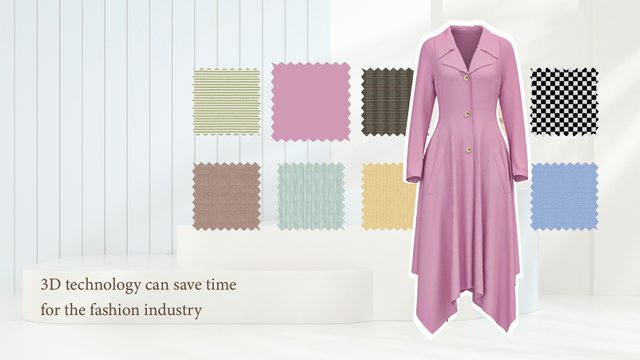
3D clothing technology has the power to shrink the garment development cycle from months into weeks and increase fashion brands’ efficiency.
A decade ago, speed was still an advantage of fashion brands. However, it is now a basic requirement for apparel production. Huge successes of fast fashion brands, like Zara, Topshop, etc., proved that the secret of following the fashion is not just a unique style, but also a high speed.
3D technology’s high speed is not just about short product development periods, but also better-prepared product concepts, adequate validation time and better quality collections. With such technology, designers can easily edit their designs digitally and embed rigid parts like buttons and trims quickly. Adopting this high-automated technology means a more effective approach to success. Five reasons are listed below to illustrate how 3D fashion design technology accelerates your product development process.
1. High Design Speed
3D technology provides designers a faster way to ideate their concept, and offers pattern makers a more convenient method to turn the fashion drawings into patterns. 3D fashion design software, like Clo3D, 3D digital fashion design platforms, like Seemsay, and even some brands who wishes to shift to digital design, have built-in model libraries, where millions of 3D garment models are available for reference. Pattern makers can also access to prepared block patterns for easy use. Iterations can be done digitally with a single click in front of a computer screen, which dramatically speeds up the design process.
2. No Communication Barriers
Digital fashion design technology enables designers, pattern makers, fit technicians, garment manufacturers, fabric and trim suppliers as well as other roles in garment development process to communicate their ideas with products modeled on virtual avatars online instead plain drawings on paper. The digital prototype can presents a true-to-life display of the silhouette and fittingness of a garment on a live fit model. By depicting designers’ concept vividly, 3D clothing technology assists teams to avoid misunderstanding caused by manual errors and communicate internally and externally through sharing all reviews and comments directly on a photo-realistic avatar. Product developers can have immediate and feedback from team members without having to wait for weeks for revised physical samples.
3. Shorter Decision-Making Time
In 3D clothing process, a physical sample will not be made until the digital prototype is approved. All product development processes rely on 3D digital sample, which can be created much faster than physical ones. The key point of digital fashion design is rendering a digital garment nearly the same to the appearance of a physical prototype, allowing product developers to make decisions quickly without the need to see a physical garment on human models.
4. Eliminating Unnecessary Steps
3D clothing technology eliminates the troubles of delivering physical samples among different teams. Such advantage will benefit hundreds of global enterprises whose designers, material suppliers and manufacturers are usually located in different countries. It fundamentally changed the outdated situation where it may take months for brands to complete the whole garment product workflow - from sketching through sampling to showrooming.
5. Facilitating Fabric and Trim Supply
Fabrics and trims in the built-in libraries of Seemsay, Clo3D and other digital fashion design solution providers, have gone through physical testings. Then, those accumulated data were fed into the databases, and then translated into a visual image presenting how such materials look like on real clothes. The accurate manifestation facilitates designers to choose the most appropriate textiles and accessories. Furthermore, the number of materials stored in a 3D fabric and trim library can be millions times more than a physical warehouse. With such libraries, brands can access to numerous raw materials in one platform instead of collecting sample information from different vendors. In addition to the raw material resources, Seemsay, the 3D clothing service platform, has attracted a plenty of fabric and trim suppliers to join in. That means, brands can get the best price through comparison.
Fashion design is a highly seasonable business, where brands must move their products to shelves within the fashion season. 3D clothing technology is a great solution for brands to speed up their production time and reduce the risks of falling behind the next trend.